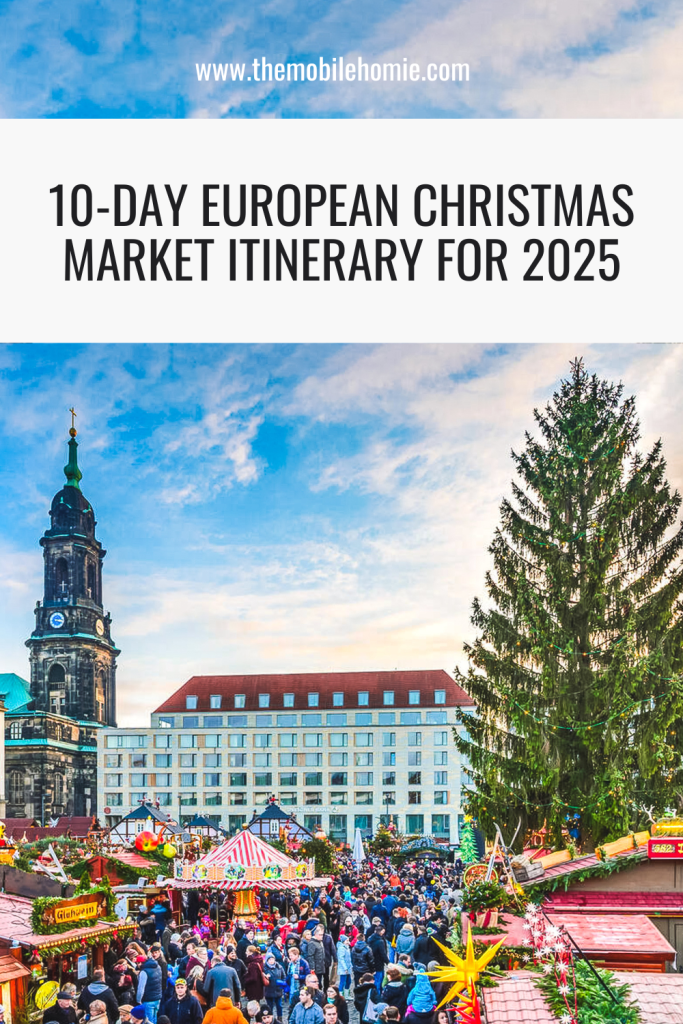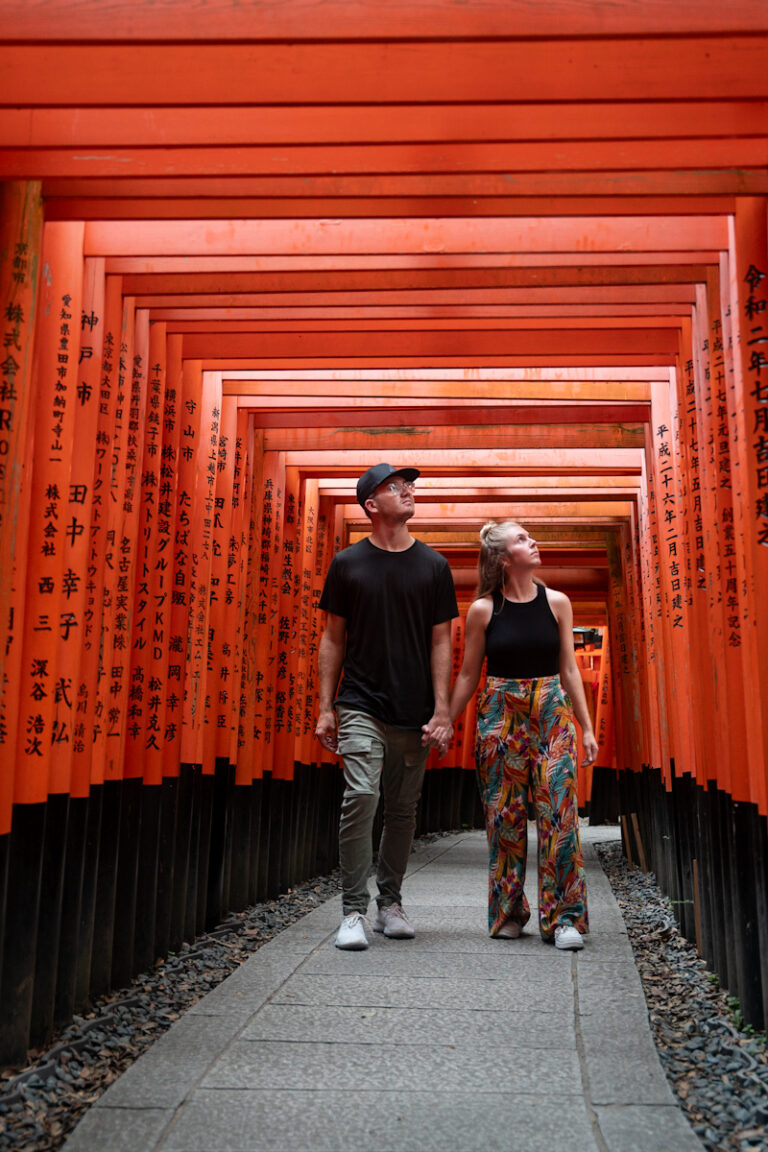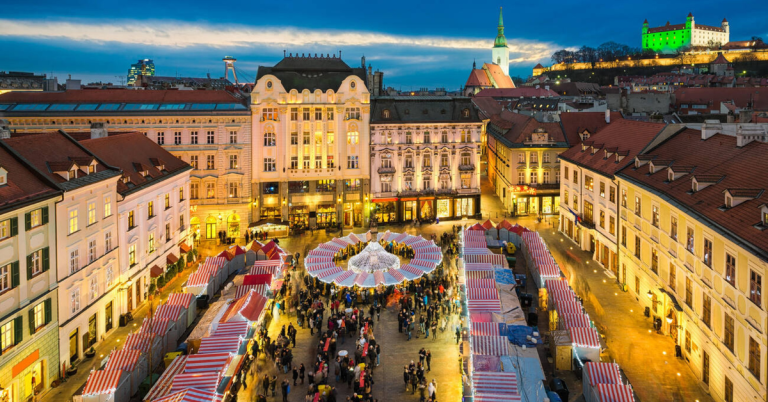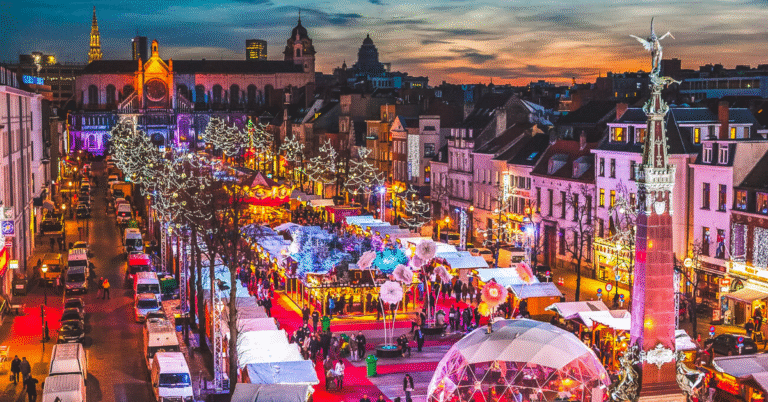Ultimate 10-Day European Christmas Market Itinerary for 2025
The Mobile Homie contains affiliate links and is a participant in the Amazon Services LLC Associates Program, as well as other affiliate programs. If you click on a link or make a purchase through one of these links, we may earn a small commission at no extra cost to you. For more details, see our Privacy Policy.
There’s something about the first sip of glühwein that hits different when you’re standing in a medieval European square. The smell of roasted chestnuts and cinnamon swirls around you, vendors call out in languages you barely understand, and suddenly you’re part of a tradition that’s been going strong for centuries.
Last December, JT and I spent two weeks chasing that exact feeling through seven European countries. We hit Budapest, Bratislava, Vienna, Tallinn, Riga, Wrocław, and Prague, spending two days in each city and covering as many Christmas markets as humanly possible. What started as a bucket list trip turned into something way more magical than we expected.
While the famous markets in Vienna and Budapest absolutely delivered on the grandeur we hoped for, some of our favorite moments happened in places most people skip entirely.
Planning a 10-day European Christmas market itinerary might seem overwhelming at first. Which cities should you hit? How do you navigate winter travel? What’s a realistic budget when you’re hopping between countries? We’re breaking down everything we learned so you can plan your own perfect festive journey through Europe without the stress we dealt with figuring it all out on the fly.
Why Visit Europe for Christmas Markets
The Magic of European Christmas Markets
What makes these markets truly special is how they transform ordinary city squares into something that feels pulled straight from a storybook. In Vienna, we watched the Rathausplatz market light up against the backdrop of the neo-Gothic City Hall, and honestly, it looked almost fake in how perfect it was.
Then we tried the kiachl from this one vendor who’d been making them the same way for decades, served with sauerkraut, and suddenly we understood why people travel across continents for this experience.

The drinks alone justify the trip. Glühwein varies wildly depending on where you are and who’s making it. We had versions that tasted like Christmas in a cup, and others that were basically hot grape juice with a splash of wine. The good ones warm you from the inside out and make you want to stand in the cold just a little bit longer.
Best Time to Visit in 2025
Most Christmas markets open in late November, typically the weekend before the first Advent Sunday. For 2025, expect markets to start opening between November 14-21. They traditionally close on December 23 or 24, though some cities extend through New Year’s.
The first weekend of December through mid-month hits that sweet spot where markets are fully operational without peak crowding. The week before Christmas brings maximum crowds as both tourists and locals finish holiday shopping. If crowds stress you out, avoid December 20-23 entirely.
Weather varies dramatically across Europe. Central Europe (Austria, southern Germany, Czech Republic, Poland) offers your best shot at that picture-perfect snowy Christmas market experience. We got lucky with light snow in Estonia and Latvia, and it absolutely elevated the entire atmosphere to another level. Western Europe tends toward cold and rainy rather than snowy.
We timed our trip for early December and it worked perfectly. Markets were fully up and running, crowds were manageable outside prime evening hours, and we locked in decent accommodation prices by booking two months ahead (though earlier would have been better).
How to Plan Your European Christmas Market Trip
Choosing the Right Route
The route we’re outlining is optimal for flying or taking a train: Vienna → Budapest → Prague → Dresden → Nuremberg → Munich → Salzburg → Zurich. This path minimizes backtracking while hitting a mix of famous markets and underrated gems. Most train segments stay under three hours, making travel days manageable.
When choosing your route, consider train connections between cities. Vienna to Budapest takes two hours. Prague to Dresden takes 2.5 hours. Munich to Nuremberg takes just one hour. These smooth connections let you maximize market time and minimize travel stress.
For detailed route planning strategies and transportation tips, check out How to Plan the Perfect European Christmas Markets Trip.
Budgeting for a Festive Getaway
Total estimated budget per person for 10 days: $2,500-4,000, including international flights, accommodation, food, local transportation, and moderate souvenir shopping.
Here’s the breakdown:
- Flights from the US: $600-1,200 round-trip
- Accommodation: €50-100 per night (€450-900 total for 9 nights)
- Food and drinks at markets: €35-45 per person per day
- Non-market meals: €15-25 per person per day
- Transportation between cities: €200-400 per person total
- Local transit: €5-8 per day (€50-70 total)
- Souvenirs: Completely variable, we spent about €100 total
In Vienna, we spent €40-50 per person per day eating and drinking exclusively at markets. Eastern European markets cut those costs significantly. In Bratislava and Wrocław, we spent €25-35 per person per day and felt like we were feasting. Budget accordingly based on which cities you emphasize.
What to Pack for Cold Weather Travel
Layering beats heavy coats every time. You’ll constantly move between cold outdoor markets, warm shops, heated transit, and your accommodation. Here’s what we each brought and actually used:
- Thermal base layers (tops and bottoms)
- 2-3 mid-weight fleece or wool sweaters
- One waterproof, windproof outer jacket
- Scarves, gloves, and hats that fit in pockets
- Waterproof boots with good traction
- One carry-on rolling suitcase and one backpack
European winter means potential snow, definitely slush, occasional rain, and constantly wet cobblestone streets. Your feet will be miserable if your shoes aren’t up to the task. We both wore insulated, waterproof boots with good traction every single day. Best decision we made in the packing process.
For a comprehensive packing guide specifically tailored to Christmas market travel, see our detailed article: What to Pack for Christmas Markets in Europe (coming soon).
Getting Around Europe (Trains, Flights, and Local Transit)
We used Omio and Rome2Rio to compare train routes and prices. Many European train tickets are cheaper the further in advance you book, especially for high-speed routes!
Our Vienna to Bratislava route cost around €15-20 per person, took one hour, and ran multiple times daily. No security lines, no checking bags, no commuting from airports to city centers. For longer distances, budget airlines like Ryanair, Wizz Air, and EasyJet connect most European cities for €30-80 per person if you book ahead and travel light.
Daily transit passes within cities cost €5-8 and cover metros, trams, and buses. We bought passes everywhere and used them extensively. In Vienna alone, we probably took 10+ transit trips across our two days, making the €8 pass an obvious value.
Budget €200-350 per person for all transportation between cities, plus another €50-70 for local transit across the 10-day trip.
10-Day European Christmas Market Itinerary
Day 1-2: Vienna, Austria
Vienna makes the perfect starting point for a European Christmas market adventure. The Austrian capital goes absolutely all-out for Christmas, with markets scattered throughout the city, each offering its own distinct atmosphere and character.
We spent two days in Vienna covering as many markets as possible, and honestly, we could have spent a week. The combination of imperial palaces, classical music heritage, and traditional Austrian coziness creates Christmas market magic that’s hard to match anywhere else in Europe.
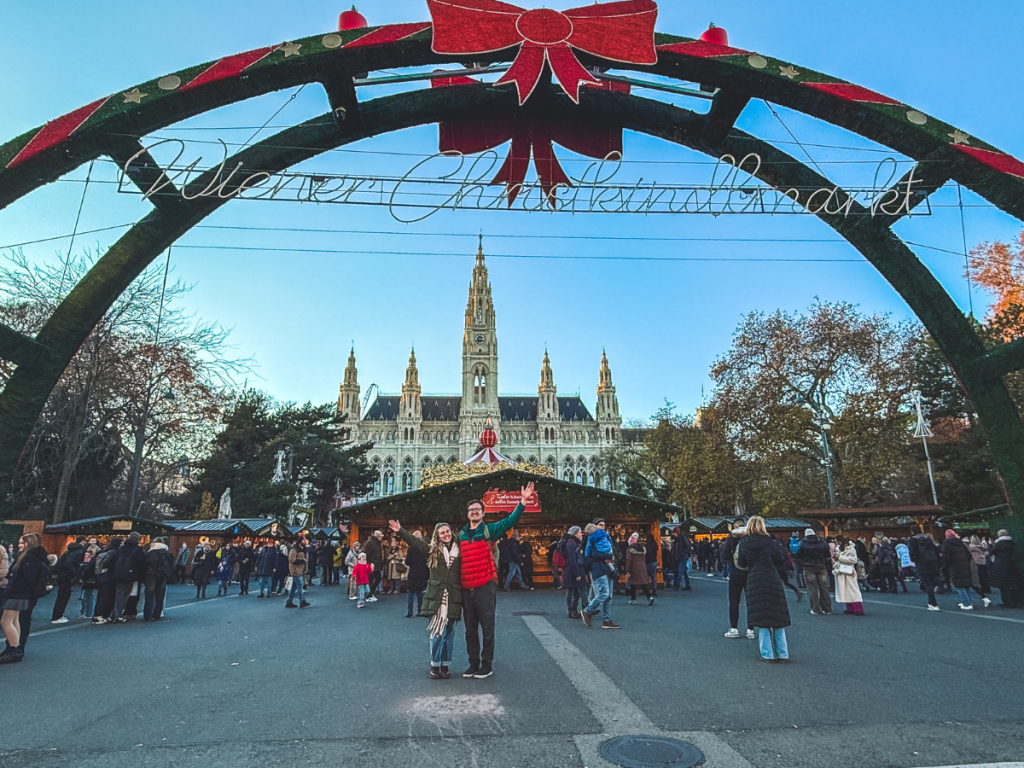
Day 1 Morning: Start at the famous Rathausplatz Christmas market in front of Vienna’s neo-Gothic City Hall. This is Vienna’s largest and most spectacular market, with over 150 stalls, an ice skating rink, and decorations that transform the entire plaza. Yes, it gets crowded, especially in the evenings and on weekends. But there’s a reason this market draws millions of visitors.
The Rathausplatz market opens at 10 AM, so arriving when it opens or around mid-day gives you breathing room before the crowds arrive. Grab a morning glühwein to ward off the cold, wander through the stalls, and take in the spectacle of it all.
Here’s where we need to talk about the kiachl vendor. This traditional Austrian fried pastry might look simple, just rounds of fried dough, but when served hot with tart cranberry sauce or sauerkraut, it achieves this perfect balance of crispy, fluffy, sweet, and savory that we still dream about.
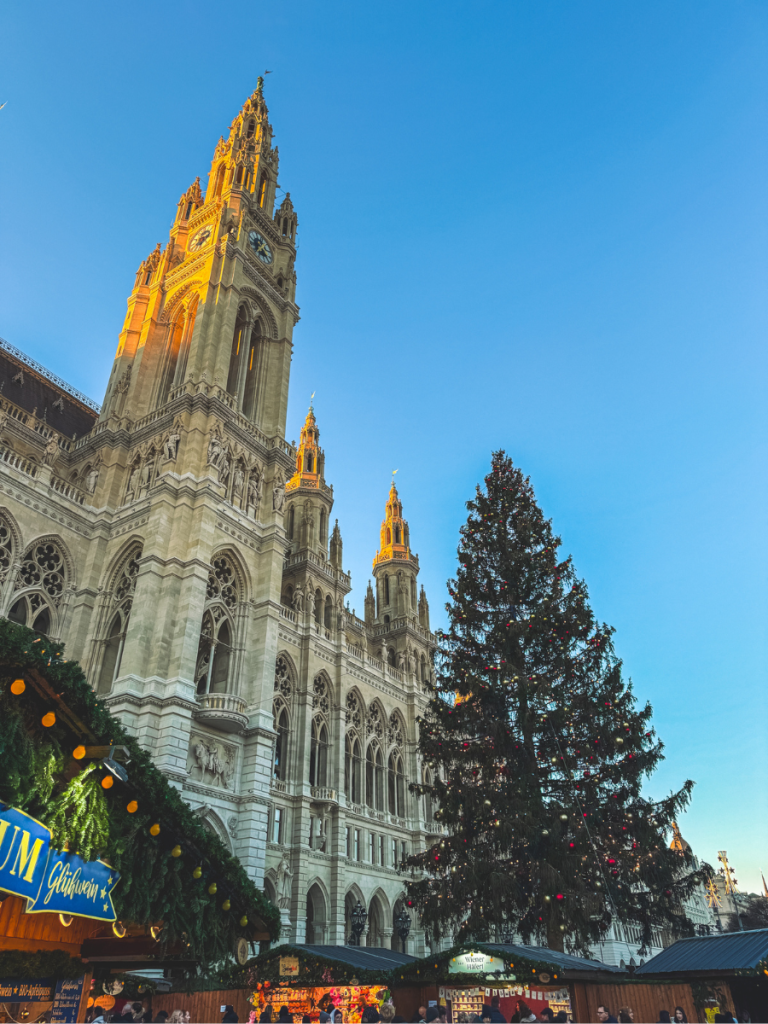
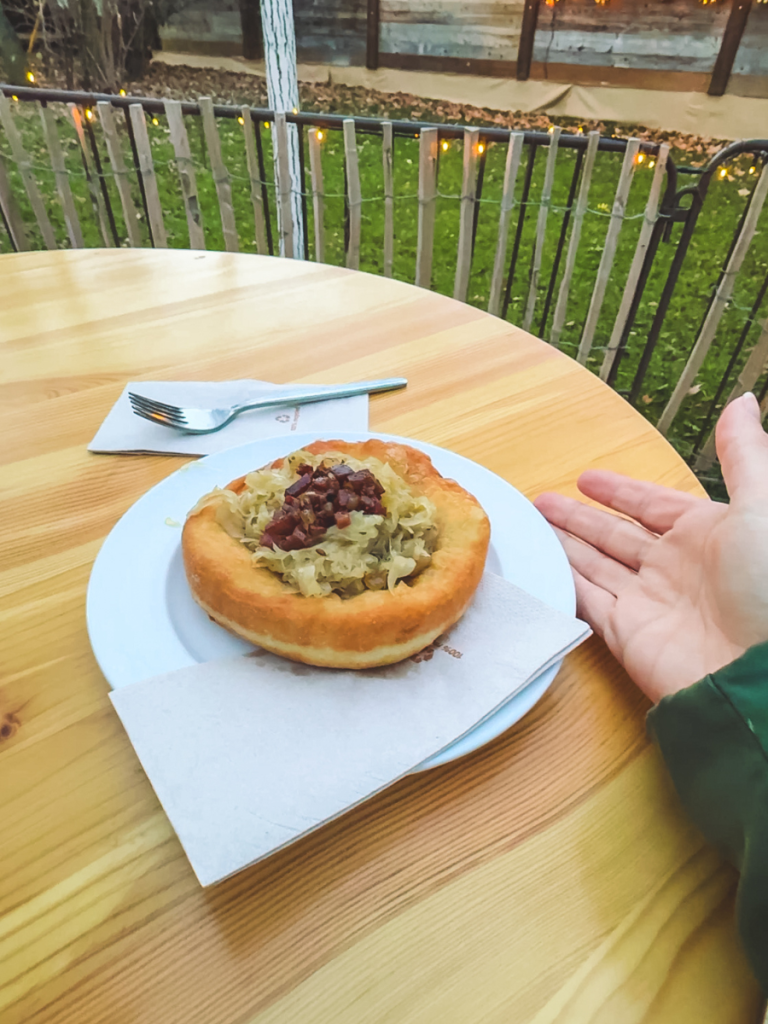
We found this specific vendor at Rathausplatz, tried it once, and came back two more times specifically for more kiachl. Not exaggerating when we say it was some of the best food either of us has ever eaten anywhere. Hunt this vendor down. Your taste buds will thank you.
Day 1 Afternoon: Walk to the Am Hof Christmas market (about 15 minutes from Rathausplatz). This became our favorite Vienna market, hands down. Am Hof offers that magical combination of local atmosphere, quality goods, delicious food, and drinks that don’t cost quite as much as the bigger tourist markets.
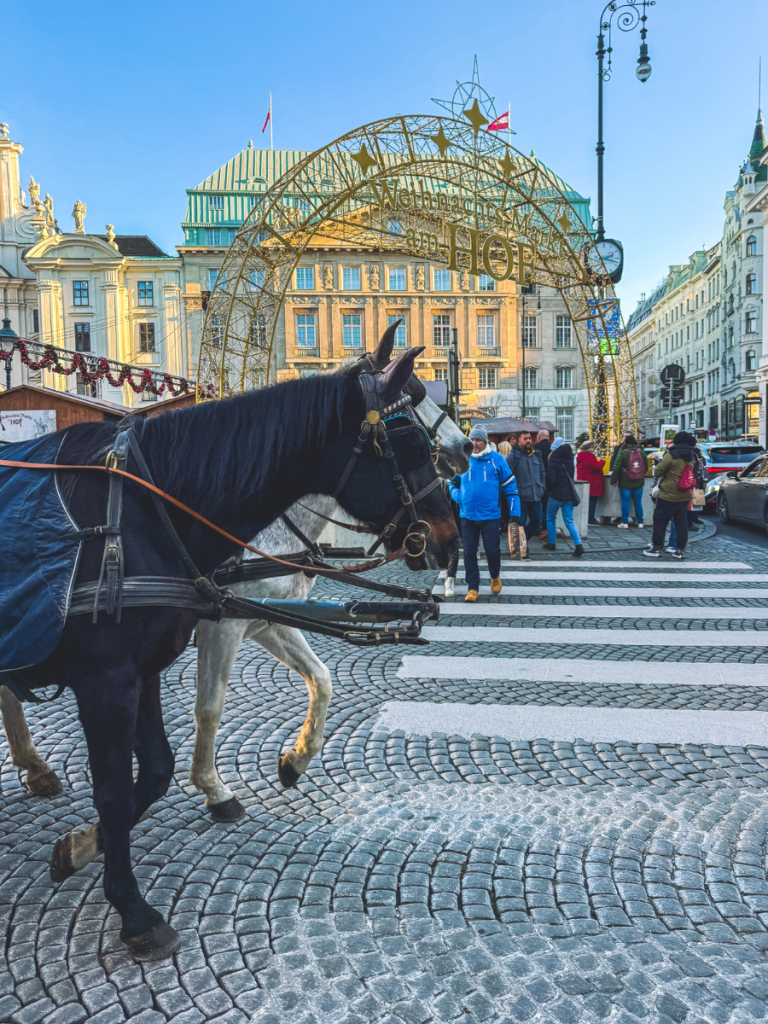
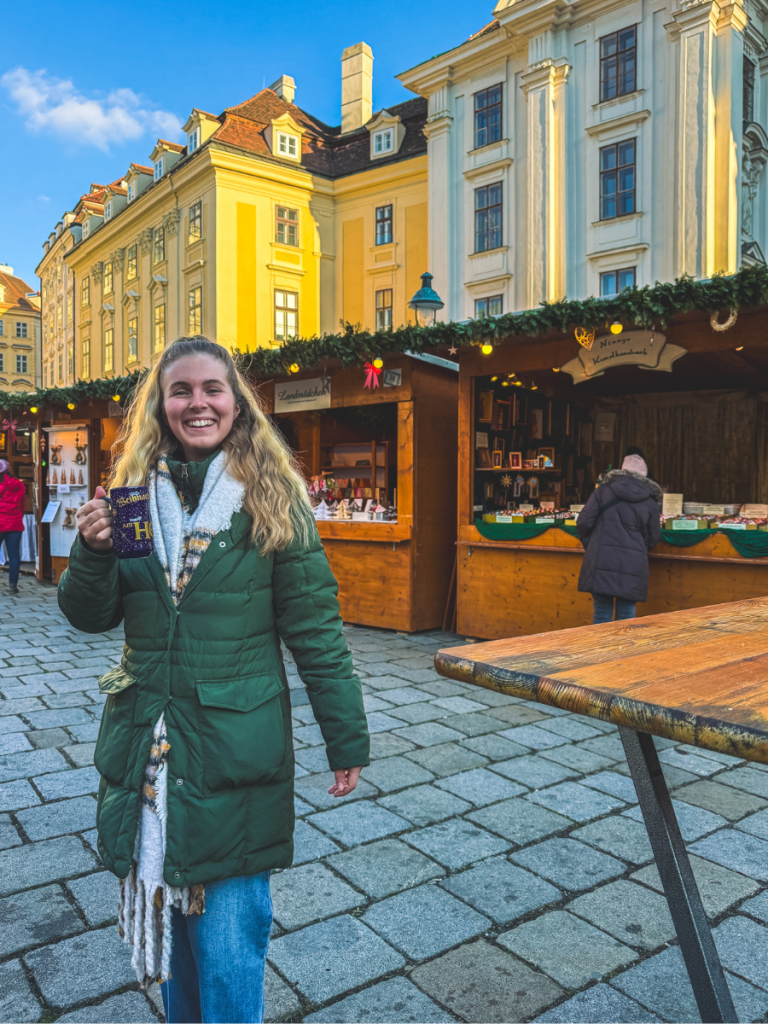
We visited Am Hof during the day and it felt genuinely local, not just a tourist attraction. Vendors had time to chat, craftspeople were actually making items at their stalls, and the whole vibe was relaxed enough that you could enjoy browsing without getting pushed along by crowds.
Day 1 Evening: Head to Stephansplatz Christmas market in front of St. Stephen’s Cathedral as the sun sets (around 4:30 PM in December). The cathedral’s Gothic spires illuminated against the night sky create one of Vienna’s most dramatic Christmas market backdrops.

Stephansplatz is more compact than Rathausplatz but beautifully designed. This is the perfect time to sample Viennese hot drinks beyond standard glühwein. Apple punsch became JT’s obsession in Vienna, with this perfect balance of fruit flavor, warming spices, and just enough alcohol to justify standing outside in the cold.
Day 2 Morning: Explore Schönbrunn Palace Christmas market. Take the U4 metro to Schönbrunn station (about 20 minutes from the center). This market runs from November 6, 2025 through January 6, 2026, making it one of the longest-running Vienna markets.
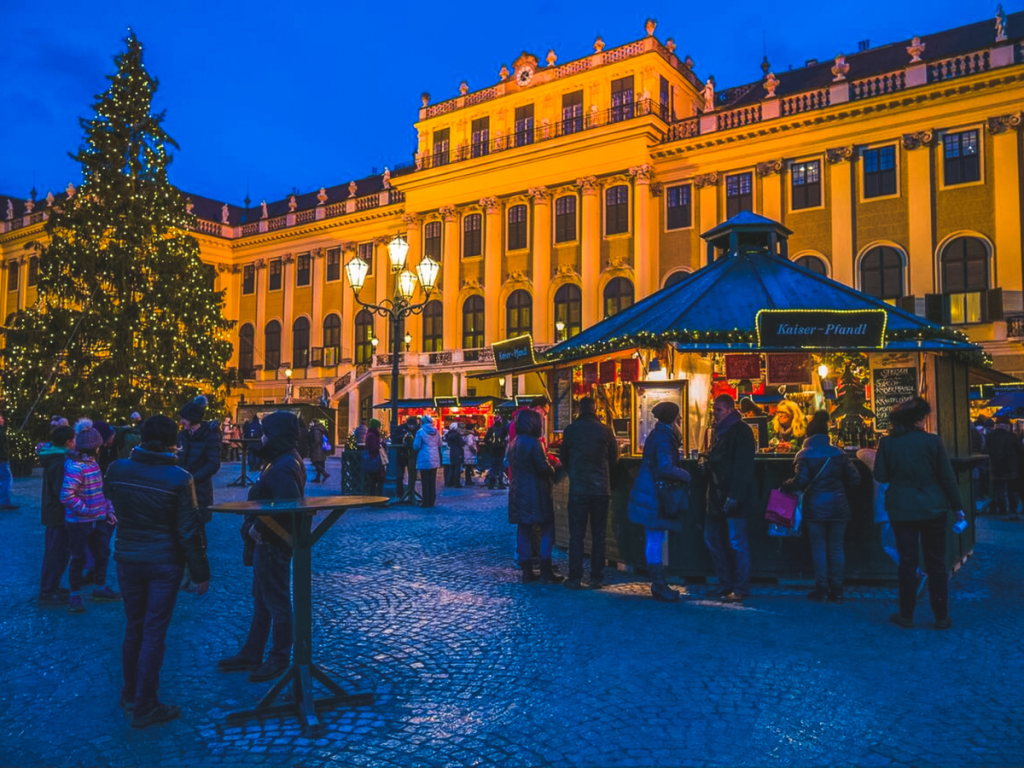
The palace backdrop elevates the entire experience. The Christmas market stalls create this elegant atmosphere that feels more refined than the busier city center markets. Crowds are generally lighter here since it requires a transit ride to reach, and the palace grounds give the market more breathing room than central Vienna locations.
Day 2 Afternoon: Visit Karlsplatz Christmas market near Karlskirche. This mid-sized market offers gorgeous views of the baroque church, fewer crowds than the major markets, and excellent artisan vendors. The atmosphere skews slightly more local, though you’ll still encounter plenty of tourists.
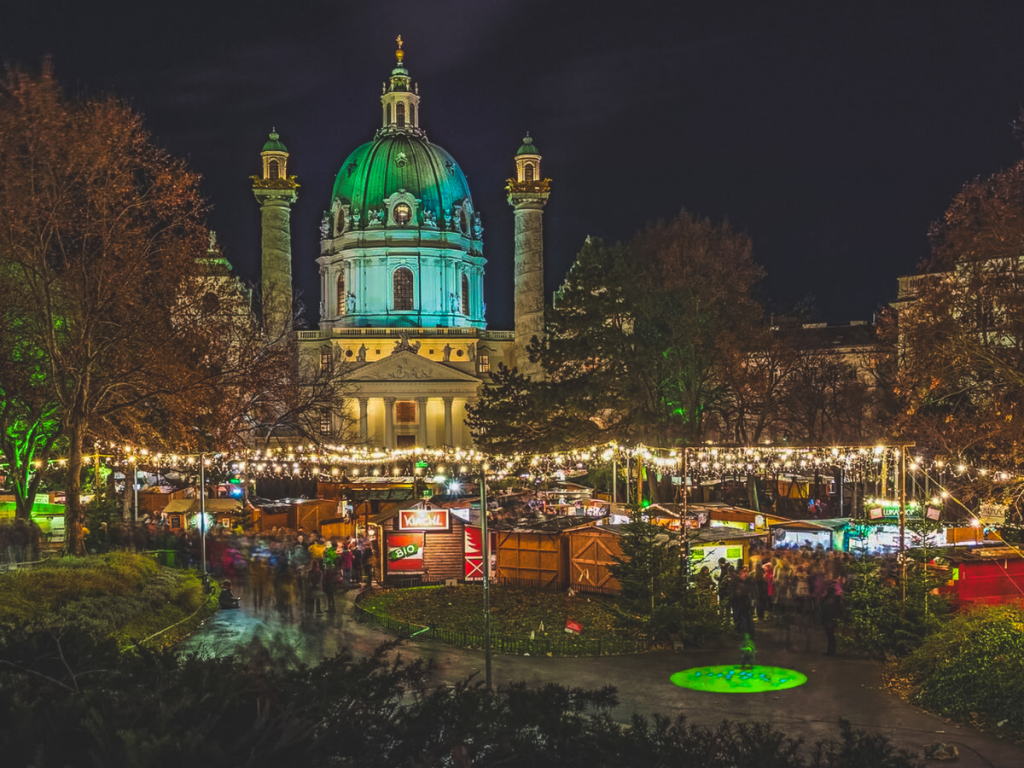
If you’re looking for serious shopping, Karlsplatz delivers quality handmade items, Austrian woolens, and traditional crafts at prices that won’t completely destroy your budget. The market sits right by the Wien Museum, so you can combine culture with Christmas market exploration.
Day 2 Evening: Return to whichever market captured your heart (probably Am Hof, if you’re like us) or explore one of Vienna’s smaller neighborhood markets. Spittelberg in the 7th district offers a charming bohemian atmosphere with narrow lanes and artisan focus, while the market at Freyung provides an elegant covered shopping experience.
Budget at least €40-50 per person per day for food and drinks at Vienna markets. We splurged a bit and don’t regret it. The experiences and flavors justified the cost. And don’t forget to keep those Christmas market mugs instead of returning them for the €5 deposit. They make excellent souvenirs and reminders of your trip.
For a complete breakdown of every Vienna Christmas market, including our detailed reviews and practical tips, check out our 2025 Vienna Christmas Markets Guide: Must-See Spots.
Where to stay in Vienna:
- Budget: JO&JOE Vienna offers a youthful, creative hostel atmosphere with private options near central markets
- Mid-Range: Max Brown Hotel 7th District brings boutique charm with easy access to the Rathausplatz market
- Luxury: Hotel Gilbert provides elegant, sustainability-focused 4-star accommodation near MuseumsQuartier and key markets
Book accommodation in the 1st (Innere Stadt) or 7th (Neubau) districts for easy walking access to multiple markets. Mid-range hotels run €100-180 per night in December, so book 3-4 months ahead for best selection and prices.
Day 3: Budapest, Hungary
After Vienna’s imperial elegance, Budapest brings its own distinct character to the Christmas market experience. Hungary’s capital combines grand architecture, thermal bath culture, and markets that feel authentically Hungarian rather than imported German traditions.
Take an early train from Vienna to Budapest (about 2.5 hours, costing €20-40 depending on booking time). You’ll arrive mid-morning with a full day to explore.

Morning: Drop your bags at your accommodation and head straight to St. Stephen’s Basilica Christmas market. This spectacular market sits in the shadow of Budapest’s largest church, with the basilica’s dome providing a dramatic backdrop.
What makes this market special is the 3D light show projected onto the basilica’s facade. Every 30 minutes after dark, the building becomes a canvas for elaborate light animations set to music. It’s touristy, sure, but it’s also genuinely impressive in a way that justifies the crowds.
The market itself offers typical Christmas market items alongside Hungarian specialties like lángos (that fried dough topped with sour cream and cheese we mentioned). Food stalls serve up traditional Hungarian street food, and the craft vendors include everything from mass-produced souvenirs to quality Hungarian embroidery and ceramics.

Afternoon: Walk to Vörösmarty Square Christmas market (about 15 minutes from St. Stephen’s). This is Budapest’s oldest and most traditional Christmas market, operating since 1998 in the heart of the city’s pedestrian shopping district.
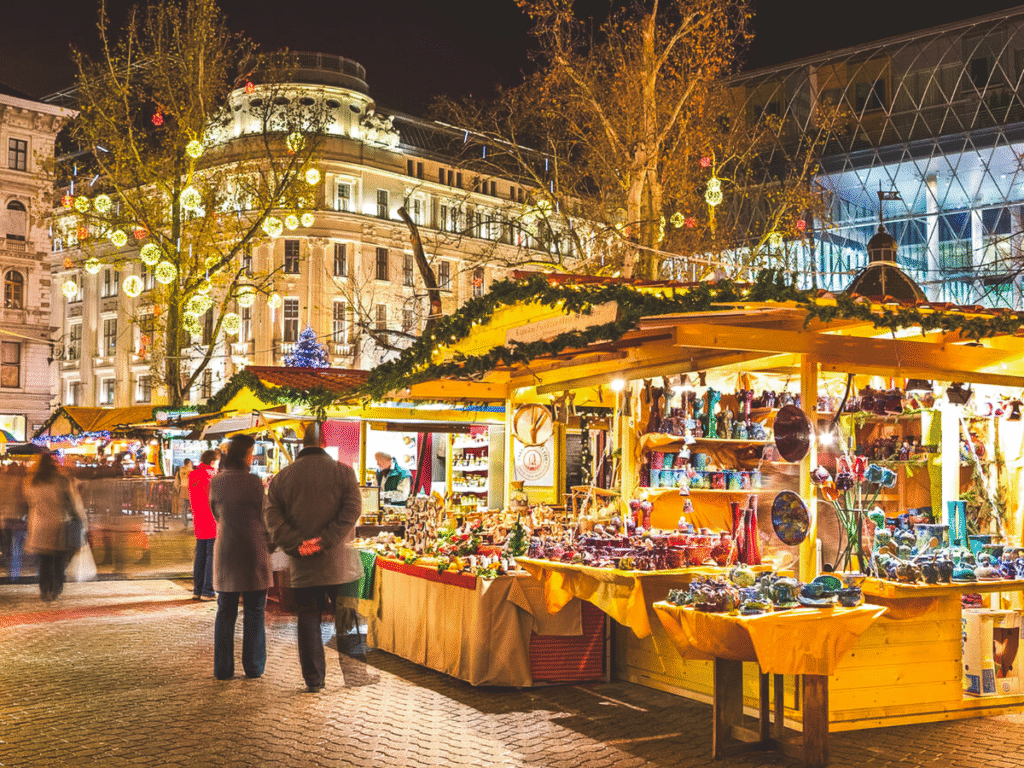
Hungarian craft traditions shine here. Look for embroidered textiles, painted eggs, Herend porcelain (expensive but exquisite), and traditional wooden toys. Food stalls serve kürtőskalács (chimney cakes), which you should absolutely try. These spiral pastries get baked over charcoal, rolled in cinnamon sugar or other toppings, and served warm. They’re sweet, crispy, slightly chewy, and addictively good.
The square itself is gorgeous, surrounded by elegant buildings and anchored by a statue of the Hungarian poet Mihály Vörösmarty. During December, the entire area becomes pedestrian-only, creating this festive atmosphere where you can wander freely between stalls without worrying about traffic.
Evening: If you have energy left, visit the Budapest Christmas Fair on the Buda side near Széll Kálmán Square. This market caters more to locals than tourists, meaning better prices and more authentic Hungarian atmosphere. You’ll find fewer international visitors here and more Budapest residents doing their actual Christmas shopping.
Or, embrace Budapest’s thermal bath culture and spend your evening soaking in hot mineral water under the stars at Széchenyi Thermal Bath. After a long day of walking through markets in the cold, those steaming outdoor pools feel absolutely incredible.
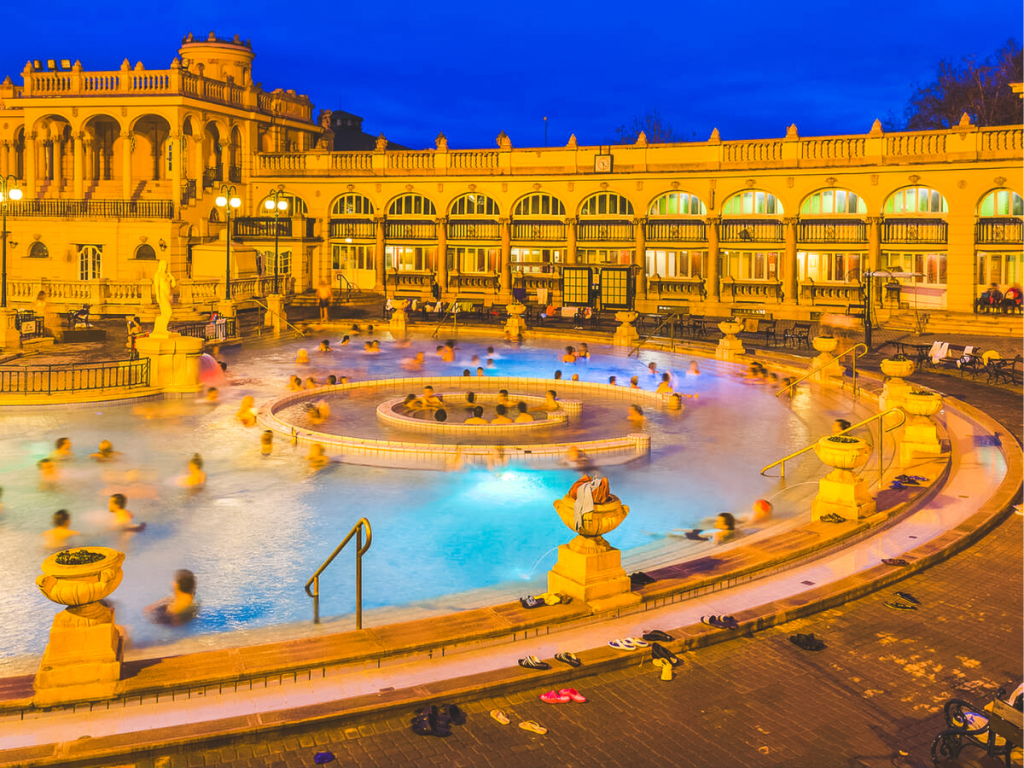
It’s not a Christmas market, but it’s such a quintessentially Budapest experience that we’re including it as an option. The baths stay open until 10 PM most nights.
Budget €35-45 per person for food and drinks at Budapest markets. Hungarian prices generally run 10-20% lower than Vienna while maintaining quality.
Where to stay in Budapest:
- Budget: Hotel Zenit Budapest Palace offers a central, modern stay steps from Deák Ferenc Square
- Mid-Range: Hotel Moments Budapest provides stylish 4-star accommodation steps from St. Stephen’s Basilica and the main market
- Luxury: Kempinski Hotel Corvinus Budapest delivers refined 5-star luxury directly facing Vörösmarty Square Christmas Market
Book accommodation in District V (city center) or District VI (Terézváros) for easy access to markets and public transit. Expect to pay €60-100 per night for mid-range options.
Day 4-5: Prague, Czech Republic
Take the morning train from Budapest to Prague (about 7 hours) or fly (about 1.5 hours). We’d recommend flying this segment if you can find reasonable fares (€50-80), as the train takes most of the day and doesn’t offer particularly scenic views for the duration.
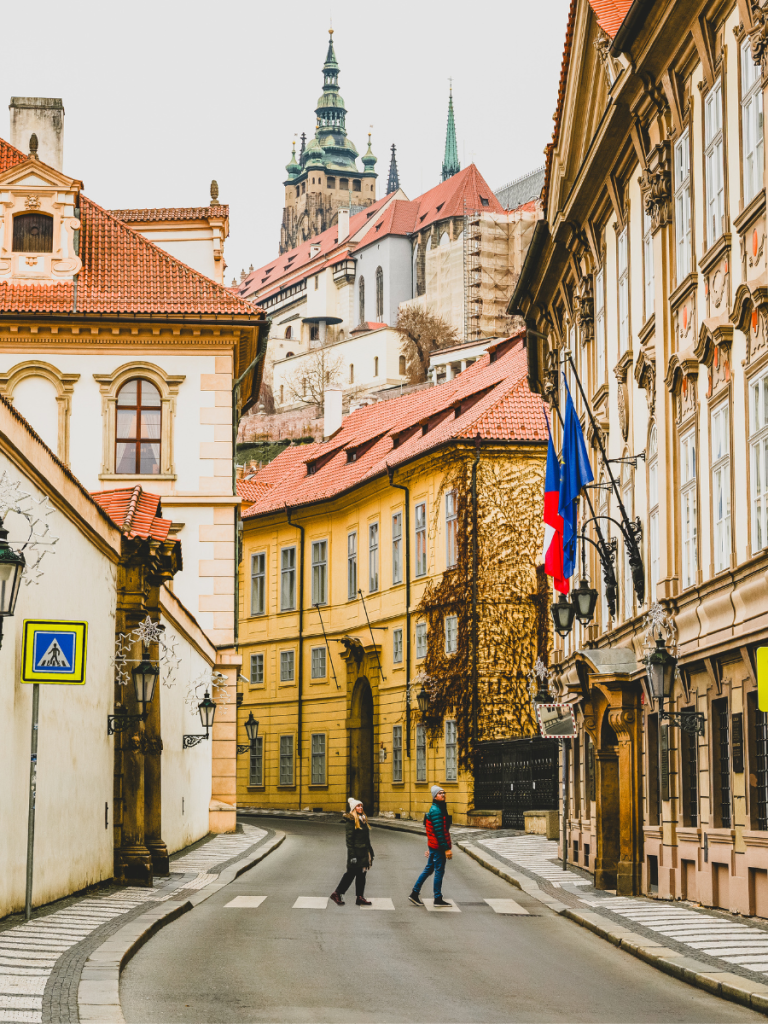
Prague’s Christmas markets combine fairy-tale architecture with Czech traditions and enough mulled wine varieties to keep you warm through multiple days of exploration.
Day 4 Afternoon: Assuming you arrive midday, drop your bags and head to Old Town Square Christmas market. This is Prague’s most famous market, and for good reason. The medieval astronomical clock, Gothic church spires, and colorful baroque buildings create a backdrop that looks almost too perfect to be real.
This market gets crowded, especially in late afternoon and evening. But the setting justifies dealing with people. Walk the entire square, checking out various vendors, before settling on which stalls deserve your money. The market sprawls across the square with a massive Christmas tree at the center and wooden stalls arranged in neat rows.
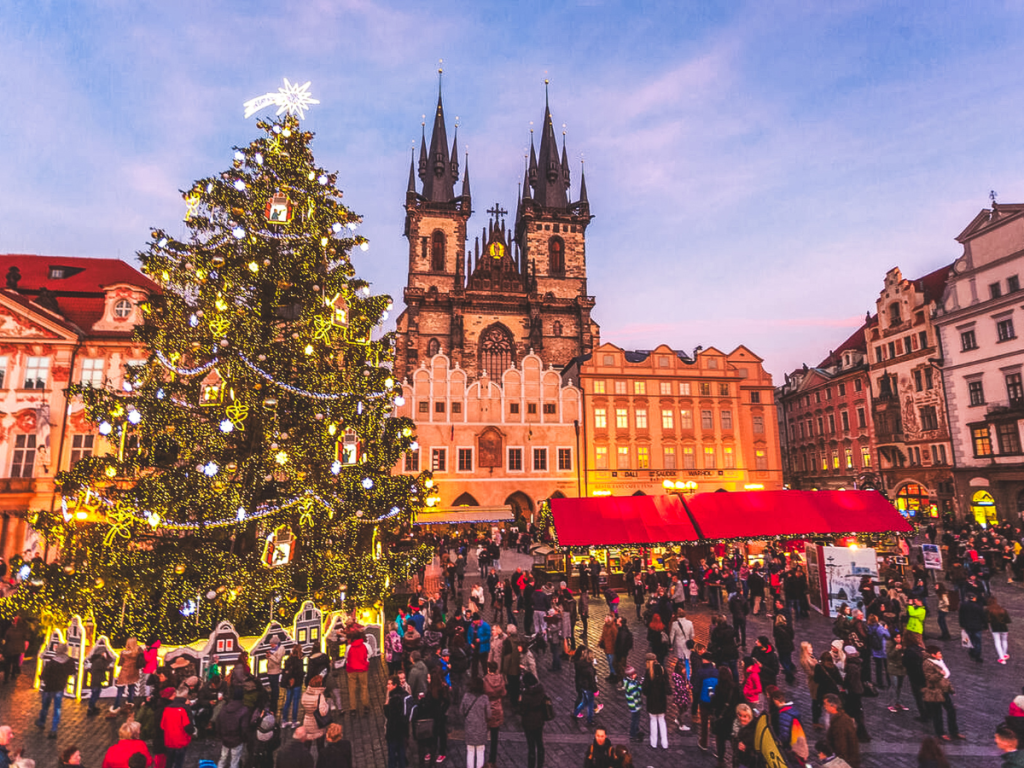
This is where we discovered bombardino, that Italian hot drink that became JT’s obsession. Eggnog mixed with brandy and topped with whipped cream creates this dessert-drink hybrid that tastes indulgent and warms you thoroughly. JT ordered a second cup immediately after finishing his first and would not stop talking about it the rest of the trip.
Czech food specialties you shouldn’t miss: trdelník (those chimney cakes we mentioned in Budapest, which actually originated in the Czech lands), klobása (Czech sausages that differ from German bratwurst in their seasoning), and svařák (Czech mulled wine, which differs slightly from German glühwein in its spice profile with more cloves and less cinnamon).
Day 4 Evening: Walk to Wenceslas Square Christmas market (about 10 minutes from Old Town). This market stretches along Prague’s famous boulevard, offering a more elongated layout than the clustered Old Town Square market.

Wenceslas Square feels slightly less touristy and more local, though you’ll still encounter plenty of visitors. Prices run marginally lower than Old Town Square, and the craft vendors include more modern and contemporary items alongside traditional Czech crafts. The boulevard setting means you’re browsing markets while surrounded by Prague’s art nouveau architecture and historic shops.
Day 5 Morning: Explore Prague Castle Christmas market. Take the tram up to Prague Castle (or walk if you want to get your steps in). This market occupies the castle courtyards with the Prague skyline spreading out below.
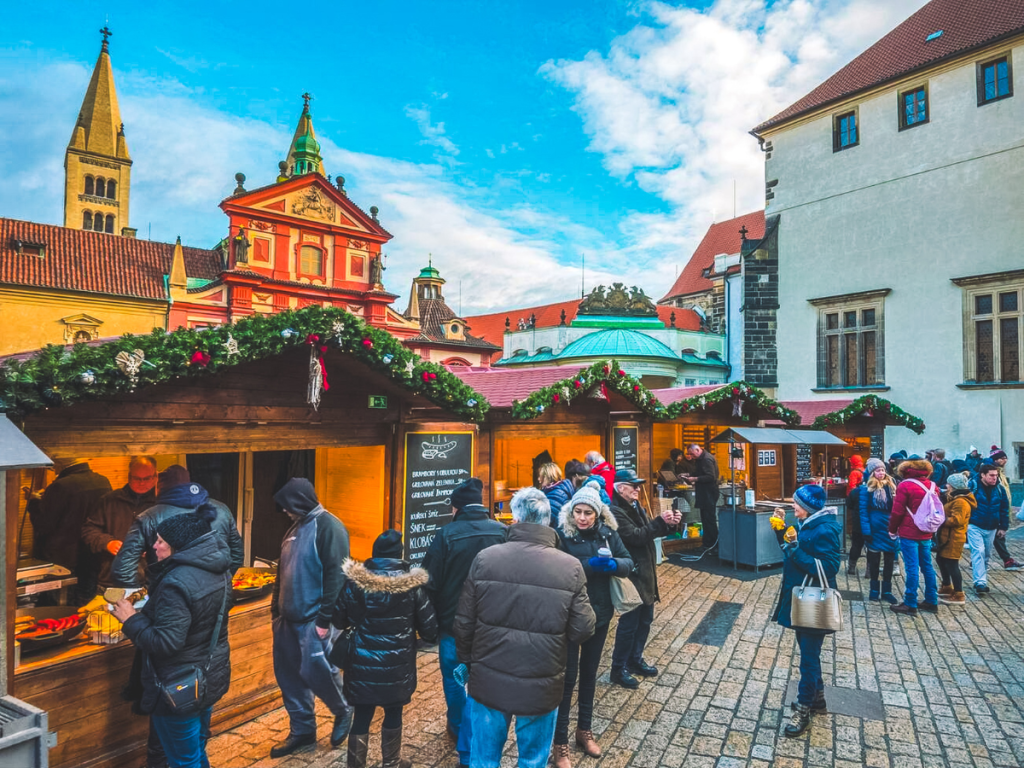
The castle market offers gorgeous views alongside traditional crafts and Czech specialties. Crowds are lighter up here since it requires more effort to reach, and the royal setting adds something special to the Christmas market experience. After exploring the market, you can tour Prague Castle itself, including St. Vitus Cathedral and the Golden Lane.
Day 5 Afternoon: Return to Old Town and explore the smaller markets in Republic Square and Na Příkopě. These markets cater more to locals doing their Christmas shopping, meaning you’ll find more practical items and fewer tourist-oriented souvenirs. The crafts tend toward useful household items, Czech glass and crystal, and locally made foods.
Day 5 Evening: Spend your final Prague evening at whichever market captured your heart (probably Old Town Square) or explore Kampa Island’s small riverside market for a quieter atmosphere. This tiny market on an island in the Vltava River offers beautiful views of Charles Bridge and a more intimate setting away from the main tourist zones.
Budget €30-40 per person per day for food and drinks at Prague markets. Czech prices undercut Austrian and German markets significantly while maintaining quality.
Where to stay in Prague:
- Budget: Old Town Square Residence by Emblem provides a central, clean stay with festive ambiance
- Mid-Range: BoHo Prague Hotel offers sleek design within walking distance to Old Town Market Square
- Luxury: Four Seasons Hotel Prague delivers riverside opulence near Charles Bridge and the main Christmas market
Book accommodation in Old Town (Staré Město) or Lesser Town (Malá Strana) for walking access to markets. Expect to pay €70-120 per night for mid-range hotels in December.
Day 6: Dresden, Germany
Take the morning train from Prague to Dresden (about 2.5 hours, costing €15-30). This is where you dive into serious German Christmas market tradition.
Dresden’s Striezelmarkt claims to be the oldest Christmas market in Europe, dating back to 1434. That’s almost 600 years of Christmas market tradition, and Dresden takes this heritage seriously.
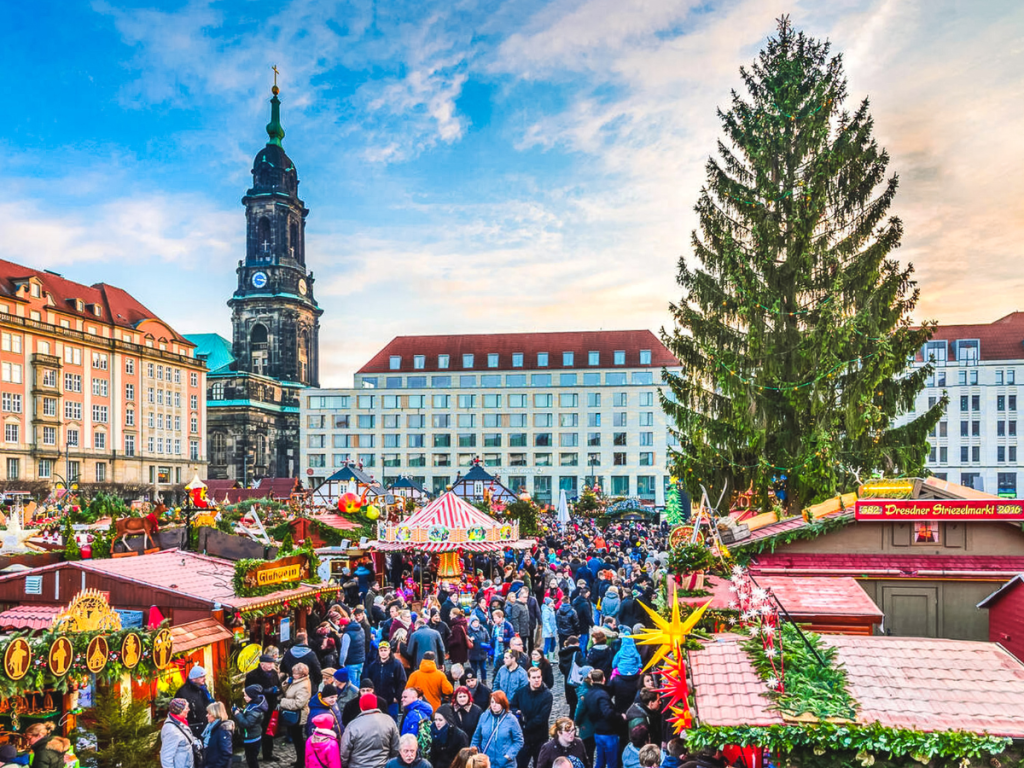
Morning: Arrive in Dresden and head straight to Altmarkt Square where the Striezelmarkt sprawls across the old market square. In the square, there’s over 200 stalls offering everything from handcrafted ornaments to Erzgebirge wooden folk art to massive Christmas pyramids.
Dresden’s specialty is Dresdner Christstollen, a traditional German fruit bread loaded with dried fruits, nuts, marzipan, and plenty of butter and sugar. This isn’t light snacking food. This is rich, dense, substantial Christmas baking that pairs perfectly with hot coffee or glühwein.
Every year Dresden bakes a giant Stollen that weighs several tons, parades it through the city, and sells slices to visitors. If you’re there during Stollen Festival (usually the second Saturday in December), this event alone justifies visiting Dresden!
Afternoon: Explore the other Dresden Christmas markets scattered throughout the historic city. The Frauenkirche Christmas market sits in front of the reconstructed baroque church and the Medieval Christmas market on the Neumarkt recreates historical Christmas market traditions with vendors in period costume and traditional crafts!
The Augustusmarkt on Hauptstraße brings a more alternative vibe with art and design focus, while the Winter Lights market near the Zwinger palace emphasizes contemporary crafts and international foods.
Budget €40-55 per person for food and drinks at Dresden markets. German Christmas markets fall into the mid-to-upper price range, but the quality typically justifies the cost.
Where to stay in Dresden:
- Budget: ibis Budget Dresden City offers convenient, practical accommodation minutes from Striezelmarkt
- Mid-Range: Star G Hotel Premium Dresden Altmarkt provides modern comfort beside Altmarkt festivities
- Luxury: Hotel Taschenbergpalais Kempinski delivers a palatial stay steps from the historic market
Book accommodation in Altstadt (Old Town) within walking distance of Altmarkt. Expect to pay €80-140 per night for mid-range hotels.
Day 7: Nuremberg, Germany
Take the early train from Dresden to Nuremberg (about 3.5 hours, costing €30-50). Nuremberg’s Christkindlesmarkt is often called the most famous Christmas market in the world, and visiting during your German Christmas market journey is basically mandatory.
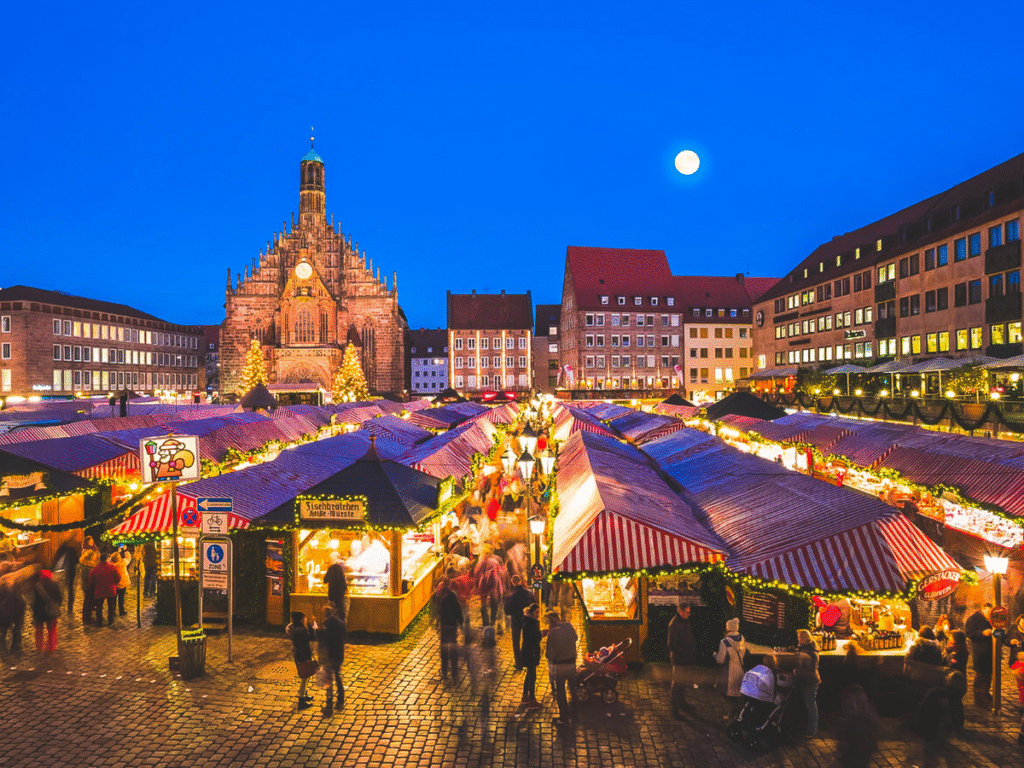
Morning/Early Afternoon: Arrive in Nuremberg and make your way to Hauptmarkt, the main market square where the Christkindlesmarkt sprawls in all its red-and-white striped glory.
Nuremberg’s Christmas market heritage runs deep. This is where many Christmas market traditions we now take for granted originated or gained widespread popularity. The market dates to the mid-1500s, and Nuremberg’s location as a trading center helped spread these traditions throughout Europe.
The market officially opens with a ceremony where the Christkind (a young woman dressed as an angel) delivers a prologue from the Frauenkirche balcony. If you’re there for opening day (usually the Friday before the first Advent), this ceremony is worth experiencing.
What to try in Nuremberg: Nürnberger Rostbratwurst (small grilled sausages served three in a bun with mustard), Nuremberg Lebkuchen (those elaborate spiced cookies covered in chocolate or glaze), and Feuerzangenbowle (a dramatic drink preparation where rum-soaked sugar gets set on fire over mulled wine).
Afternoon: The Christkindlesmarkt spreads across Hauptmarkt and into surrounding streets, so give yourself time to explore thoroughly. The Children’s Christmas Market (Kinderweihnacht) occupies Hans-Sachs-Platz with activities, rides, and vendors specifically aimed at families.
Craft shopping in Nuremberg delivers exceptional quality. Look for hand-carved wooden figurines (Nuremberg is famous for these), traditional Nuremberg tin toys, and those elaborate Lebkuchen in decorative tins that make great gifts!
Evening: As darkness falls and lights illuminate the Gothic Frauenkirche and Schöner Brunnen fountain, the Christkindlesmarkt transforms into something that feels almost magical despite the crowds. This is peak Christmas market atmosphere, worth dealing with the shoulder-to-shoulder browsing.
Budget €45-60 per person for food and drinks at Nuremberg’s market. This is one of Germany’s more expensive Christmas markets, but the experience and quality justify the cost.
Where to stay in Nuremberg:
- Budget: Hotel Agneshof provides a cozy old-town guesthouse close to Hauptmarkt
- Mid-Range: Hotel FIVE offers boutique accommodation directly beside Christkindlesmarkt with excellent breakfast
- Luxury: Sorat Hotel Saxx Nürnberg delivers premium comfort with unbeatable location overlooking the market
Book accommodation in Altstadt (Old Town) near Hauptmarkt. Mid-range hotels run €90-160 per night in December.
Day 8: Munich, Germany
Take the morning train from Nuremberg to Munich (about 1 hour, costing €20-40). Bavaria’s capital offers multiple Christmas markets scattered throughout the city, each with its own distinct character and atmosphere.
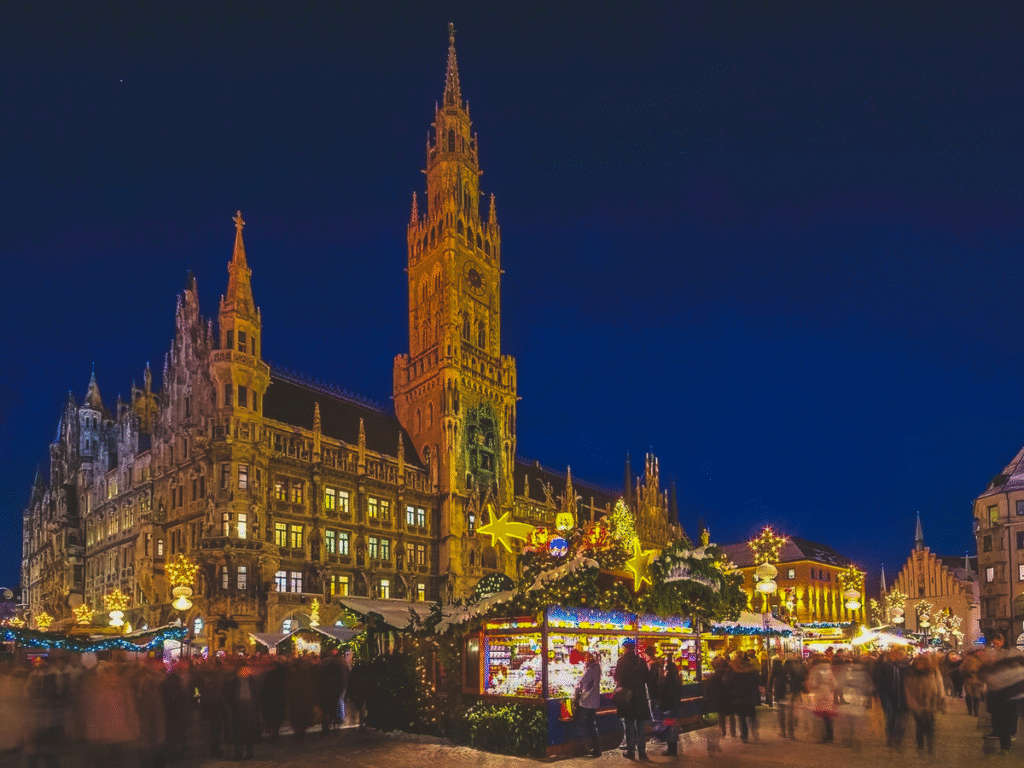
Morning: Start at Marienplatz Christmas market in front of Munich’s New Town Hall. This is the city’s most central and traditional market, with the Gothic town hall and its famous Glockenspiel providing the backdrop. The market wraps around Marienplatz and extends into pedestrian shopping streets, creating this festive trail through Munich’s historic center.
The Marienplatz market runs from late November through Christmas Eve, with stalls selling Bavarian crafts, ornaments, nativity scenes, and plenty of food and drink options. Watch for the Glockenspiel performance at 11 AM and noon (also 5 PM in summer, but not during winter), when mechanical figures act out historical Bavarian scenes.
Afternoon: Walk to Viktualienmarkt Christmas market (about 5 minutes from Marienplatz). This permanent food market transforms for Christmas, with vendors adding festive items to their regular offerings. The atmosphere here skews more local, with Munich residents doing their actual Christmas shopping alongside tourists browsing for souvenirs.
Viktualienmarkt offers incredible food! Make sure to try leberkäse (a sort of German meatloaf served hot in a bun with mustard), Bavarian pretzels the size of your head, or käsespätzle (German egg noodles with cheese that’s basically Bavarian mac and cheese).
Then explore the medieval Christmas market at Wittelsbacher Platz, which recreates historical market traditions with craftspeople demonstrating old techniques like blacksmithing, candle-making, and traditional toy-carving. Vendors wear period costume, and the market emphasizes authentic medieval crafts and foods.
Budget €45-60 per person per day for food and drinks at Munich markets. Bavarian portions are generous, so you might spend less than other German cities despite similar per-item prices.
Where to stay in Munich:
- Budget: Hotel Blauer Bock provides charming and affordable accommodation near Marienplatz
- Mid-Range: Platzl Hotel offers classic Bavarian style minutes from Munich’s main market
- Luxury: DO & CO Hotel München delivers five-star refinement steps from the market and Hofbräuhaus
Book accommodation near Marienplatz or in Schwabing for easy access to markets and excellent public transit connections. Expect to pay €100-180 per night for mid-range hotels.
Day 9: Salzburg, Austria – Sound of Music Meets Holiday Cheer
Take the morning train from Munich to Salzburg (about 1.5-2 hours, costing €30-50). Mozart’s birthplace and the setting for The Sound of Music transforms into a winter wonderland during Christmas season, with Alpine peaks providing a dramatic backdrop to festive markets.
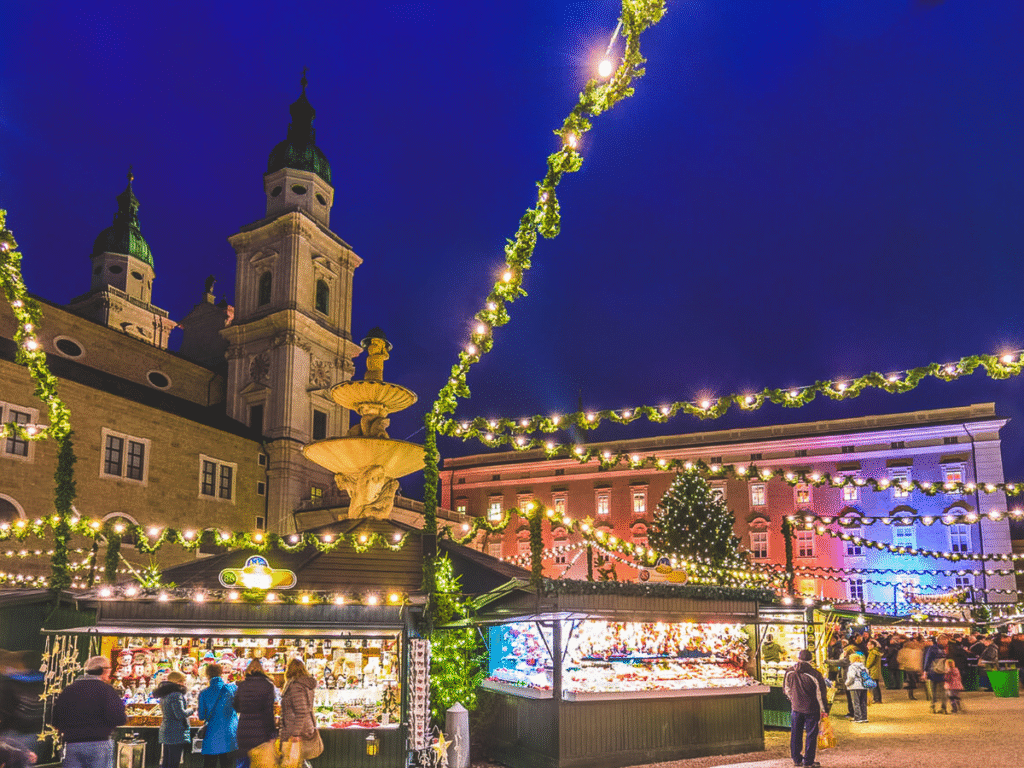
Morning/Afternoon: Arrive in Salzburg and head to the main Christmas market in Residenzplatz and Domplatz. These connected squares in Salzburg’s baroque old town host the city’s largest and most spectacular Christmas market, with over 90 stalls offering Austrian crafts, traditional foods, and plenty of glühwein.
The cathedral and residenz palace create an incredibly photogenic setting. When snow falls, the entire scene looks like something from a Christmas card. We’ve been to Vienna during multiple seasons (spring, summer, and winter), but there’s something special about Alpine Christmas markets that delivers a different kind of magic.
Salzburg’s markets emphasize Austrian traditions rather than generic German imports. Look for hand-carved nativity scenes (Salzburg has a strong Catholic tradition and these are serious works of art), traditional Austrian woolens, and Mozartkugel (those chocolate balls filled with marzipan and nougat).
Afternoon: Walk through Salzburg’s charming old town, exploring smaller markets like the one at Sternbräu. The compact old town means you can easily cover multiple markets on foot, stopping in historic cafes between markets to warm up with proper Viennese coffee and sachertorte.
If you’re a Sound of Music fan, the Mirabell Gardens (where “Do-Re-Mi” was filmed) look beautiful even in winter, and several Christmas market stalls set up in Mirabellplatz adjacent to the gardens. The setting isn’t as elaborate as the main markets, but combining it with garden exploration makes for a pleasant afternoon walk.
The Salzburg Advent Singing performances happen throughout December in various venues, offering traditional Austrian folk music and Christmas carols. If you enjoy classical music, Salzburg’s concert halls host numerous Christmas performances, and experiencing Mozart in his birthplace feels especially appropriate during the holiday season.
Evening: The markets stay open until 8 PM most nights, so you have plenty of time to explore. As evening falls, the markets take on this especially cozy atmosphere, with Alpine cold making those warm drinks and roasted chestnuts even more appealing.
Austrian Christmas markets serve punsch and glühwein variations that differ slightly from German versions. The punsch tends to be fruitier, often made with apple or cherry juice mixed with rum or schnapps. We tried several variations and found ourselves preferring the Austrian style over the more wine-forward German glühwein.
Budget €40-55 per person for food and drinks at Salzburg markets. Prices run slightly lower than Munich, though higher than Eastern European alternatives.
Where to stay in Salzburg:
- Budget: B&B Flöckner offers a quiet, family-run stay within short walking distance to Old Town markets
- Mid-Range: IMLAUER Hotel Pitter Salzburg provides excellent breakfast and views of Hohensalzburg Fortress
- Luxury: Hotel Sacher Salzburg delivers historic grandeur on the Salzach River, iconic for Christmas stays
Book accommodation in the old town (Altstadt) for walking access to markets, or across the river in Neustadt where prices drop slightly. Expect to pay €90-150 per night for mid-range hotels.
Day 10: Zurich, Switzerland
Take the morning train from Salzburg to Zurich (about 5.5-6 hours). Yes, this is your longest train journey of the trip, but the route through the Austrian and Swiss Alps delivers spectacular mountain scenery that makes the time pass quickly. Book this segment well in advance for best prices (€50-90 per person).
Alternatively, you could fly from Salzburg to Zurich (about 1 hour flight time), though factoring in airport arrival time, security, and getting from Zurich airport to the city center, you won’t save much time overall. The train journey offers better scenery and drops you directly in the city center.
Zurich makes a fitting finale for your European Christmas market journey, bringing Swiss efficiency, Alpine charm, and quality that justifies Switzerland’s famously high prices.
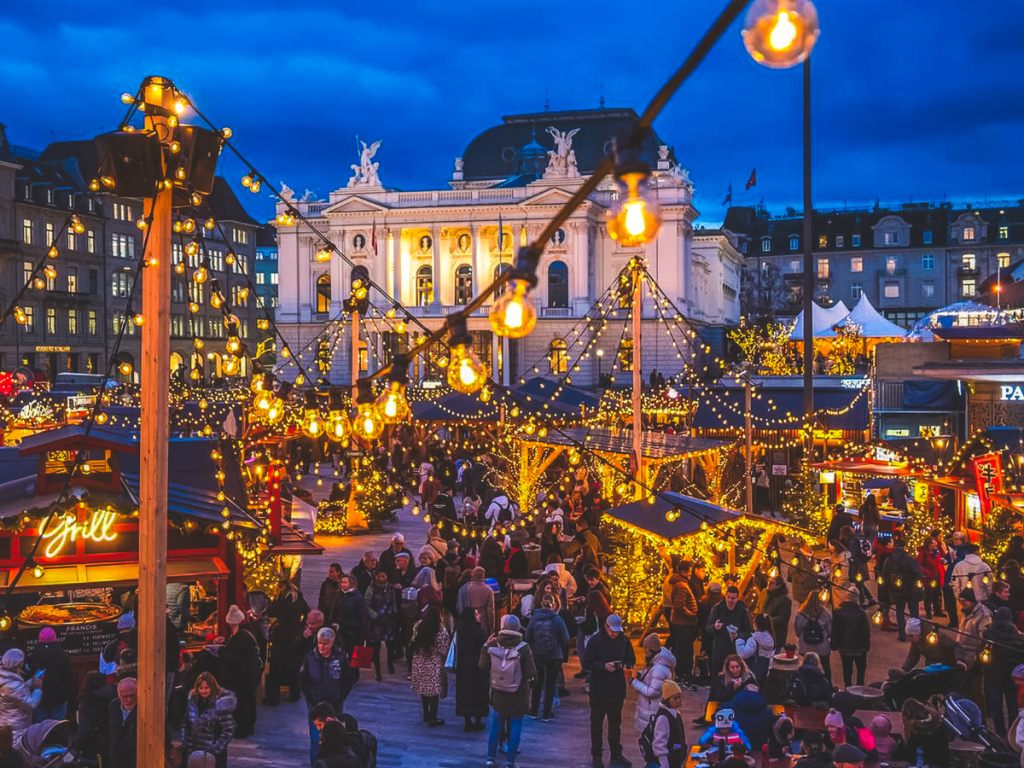
Afternoon: Arrive in Zurich and head to the Christmas market at Zurich Hauptbahnhof (main train station). This indoor market features a massive Christmas tree (allegedly Europe’s largest indoor Christmas tree, though several other markets make similar claims) and dozens of stalls selling Swiss crafts, chocolates, and holiday treats.
The station market offers convenient shopping for last-minute gifts and Swiss chocolates to bring home, with vendors emphasizing Swiss quality and craftsmanship.

Late Afternoon: Walk to the Christmas village at Sechseläutenplatz in front of the opera house. This market creates a cozy village atmosphere with wooden chalets, twinkling lights, and that Swiss attention to detail that makes everything feel just a bit more refined than other markets.
Try raclette (melted Swiss cheese scraped onto bread or potatoes), Swiss bratwurst (which differs from German versions in its seasoning and typically higher quality meat), and of course, Swiss hot chocolate made with actual Lindt or Cailler chocolate. Your wallet will cry at Swiss prices (expect to pay 30-50% more than German or Austrian markets), but the quality typically delivers.
Evening: Explore the old town Christmas markets along Niederdorf and around the Grossmünster church. These smaller markets scattered through Zurich’s medieval streets offer a more intimate atmosphere than the larger markets, with local artisans and Swiss specialties.
The Singing Christmas Tree at Werdmühleplatz is a Zurich tradition where a giant illuminated tree serves as a stage for choirs performing Christmas carols. Performances happen most evenings in December, and it’s a lovely (free) experience that captures Swiss Christmas spirit.
Make sure to end your European Christmas market journey with a proper Swiss dinner at a traditional restaurant. Fondue or raclette makes a fitting celebratory meal after 10 days of market hopping. Swiss restaurants take their cheese seriously, and the communal nature of fondue feels appropriate for celebrating the end of your journey!
Budget €60-90 per person for food and drinks at Zurich markets. Switzerland is expensive, period. After nine days of more affordable markets, splurging on your final day feels justified, and Zurich delivers quality that makes the prices slightly easier to swallow.
Where to stay in Zurich:
- Budget: Hotel Bristol Zurich offers rare affordable accommodation 5 minutes from Zurich Hauptbahnhof
- Mid-Range: citizenM Zürich provides modern, automated comfort near Bahnhofstrasse markets
- Luxury: Baur au Lac delivers Zurich’s legendary five-star experience with its own festive displays
Book accommodation in Niederdorf (old town) or near Hauptbahnhof for easy access to markets and the train station if you’re catching a flight the next day. Expect to pay €150-250 per night for mid-range hotels. Switzerland doesn’t do budget accommodation the way other European countries do.
Frequently Asked Questions
What Is the Best Country for Christmas Markets?
This depends entirely on what you’re looking for in a Christmas market experience. Germany invented the Christmas market tradition and still does it best in terms of scale, variety, and traditional atmosphere. Cities like Nuremberg, Munich, and Dresden deliver that “German Christmas market” experience with lebkuchen, glühwein, and centuries of tradition baked into every stall.
Austria brings imperial elegance to Christmas markets, with Vienna and Salzburg offering spectacular settings against baroque palaces and Alpine backdrops. Austrian markets emphasize gemütlichkeit and quality over sheer size. The craftsmanship tends to run higher, and there’s something about sipping punsch in front of a Habsburg palace that creates a different kind of magic than German markets.
Eastern European countries like Czech Republic, Poland, and Slovakia offer incredible value, authentic local atmospheres, and fewer crowds. We were genuinely blown away by markets in Bratislava and Wrocław during our actual trip, where we got that magical Christmas market experience without the overwhelming tourists. For more on these hidden gems, check out our guide to the Most Underrated European Christmas Markets to Visit in 2025.
France (particularly Alsace) combines French culinary excellence with Germanic Christmas market traditions, creating unique markets in stunning medieval settings. Strasbourg claims the oldest Christmas market in Europe, and the half-timbered houses of Alsatian towns create backdrops that rival anything Germany offers.
The honest answer? Visit multiple countries if you can. Each brings its own character to Christmas markets, and experiencing those differences makes the trip richer than sticking to a single country. The itinerary we’ve outlined hits Austria, Hungary, Czech Republic, Germany, and Switzerland specifically to give you that variety.
How Many Markets Can You Realistically See in 10 Days?
This depends on your travel style and how you define “seeing” a market. If you’re doing quick visits just to say you were there, you could hit 20+ markets across 10 days. But that sounds exhausting and misses the point entirely.
We’d recommend this approach: 6-8 cities across 10 days, with 1-2 full days in each location. In larger cities like Vienna or Munich, you can easily visit 3-4 markets in a single day by planning your route strategically. Smaller cities like Salzburg might have one main market that you can thoroughly explore in an afternoon, plus a few smaller neighborhood markets.
This itinerary we’ve outlined hits 8 cities: Vienna, Budapest, Prague, Dresden, Nuremberg, Munich, Salzburg, and Zurich. Realistically, you’ll visit 20-25 individual markets across those 10 days if you’re actively seeking them out in each location.
Quality beats quantity when it comes to Christmas markets. We’d rather spend an hour really experiencing a market, trying different foods, chatting with vendors, and soaking up the atmosphere than rushing through five markets just to check them off a list.
Allow time to revisit markets you loved. We went back to Vienna’s Am Hof market twice because the atmosphere and food were that good. Don’t feel pressured to see every market in every city. Sometimes finding your favorite spot and returning to it creates better memories than constantly moving to the next location.
Are European Christmas Markets Family Friendly?
Absolutely. Most European Christmas markets are designed to be family-friendly experiences, with specific areas and activities targeting children and families. That said, family-friendliness varies by market and by what age children you’re traveling with.
Many larger markets include dedicated children’s areas with carousels, small trains, puppet shows, and activities designed specifically for kids. Nuremberg’s Kinderweihnacht (Children’s Christmas Market) is entirely focused on families. Munich, Vienna, and most major German cities include similar family zones within their Christmas markets.
Toddlers and young children generally do well at Christmas markets if you manage expectations. The lights, decorations, and festive atmosphere captivate most kids. The challenge comes from crowds, cold weather, and the reality that markets primarily cater to adults shopping and drinking.
Older children and teenagers typically enjoy Christmas markets, especially if they’re interested in the food, shopping for gifts, or experiencing European culture. The novelty of traveling through European cities and trying new foods appeals to most kids over age 10-12.
For specific family-friendly itinerary suggestions and tips, we’re developing a comprehensive guide in our upcoming article: European Christmas Markets 2025: A Local-Inspired Ultimate Guide (coming soon).
Final Thoughts
Planning a 10-day European Christmas market itinerary requires balancing logistics, budget, and authentic experiences into a journey that delivers holiday magic without constant stress. We’ve given you the framework, but the best Christmas market trips always include those unplanned moments that you can’t schedule in advance.
Maybe you’ll discover your own version of that kiachl vendor in Vienna who changes your understanding of what fried dough can be. Maybe you’ll find yourself in a small neighborhood market in Salzburg where a vendor explains three generations of family tradition while wrapping your purchase. Maybe you’ll try bombardino in Prague and spend the rest of the trip trying to find it again at every market you visit.
The destinations we’ve outlined represent a mix of famous Christmas market cities and efficient routing. Vienna delivers imperial elegance, Budapest brings Hungarian character, Prague offers fairy-tale Gothic charm, and the German markets in Dresden, Nuremberg, and Munich provide that authentic Christkindlmarkt experience. Salzburg adds Alpine beauty, and Zurich brings Swiss refinement to close out your journey.
But don’t feel locked into this exact itinerary. Swap Zurich for Strasbourg if you prefer France to Switzerland. Replace Budapest with Bratislava and add an extra day in Vienna (seriously, check out our 2025 Bratislava Christmas Markets: The Ultimate Guide if you want to explore that option). Exchange Dresden for Cologne and spend more time in the Rhineland. The route we’ve provided offers a solid foundation, but personalizing it to match your interests creates a better trip.
What matters most is choosing destinations that match your interests, booking accommodation and major transportation early, and leaving enough flexibility to follow your curiosity when you discover something unexpected. December in Europe books up months in advance, so start planning now rather than waiting until fall.
Start planning your European Christmas market trip now. Research destinations, compare flight prices, and book that accommodation before the best options disappear. Three to four months ahead is ideal for booking. We learned this lesson by booking only two months out and finding options already constrained.
And if you take anything from our experience hopping through seven countries and dozens of Christmas markets, remember this: the perfect Christmas market trip isn’t about seeing the most markets or visiting the most famous cities. It’s about finding those moments, whether in Vienna’s grand Rathausplatz or a cozy local celebration in a city most people have never heard of, where you connect with European holiday traditions in ways that create memories lasting far longer than December.
Now get planning, and get ready for the Christmas market adventure of a lifetime.
